|
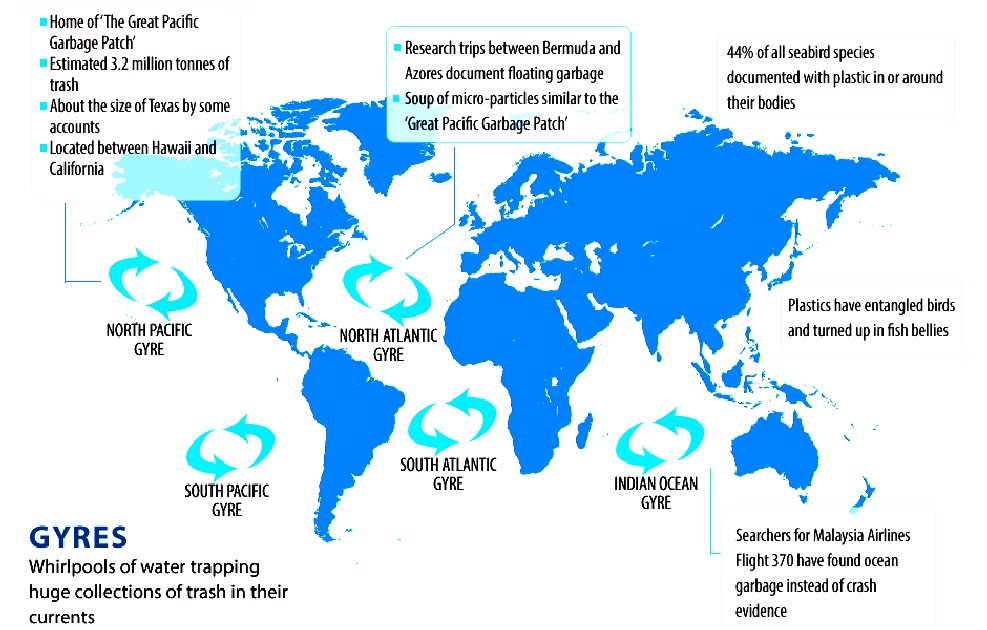
BUILD
UP
- Plastic has accumulated in five ocean hot spots called
gyres, seen here in this world map derived from information
published by 5 Gyres.
The movement of the world’s major ocean gyres helps drive the “ocean conveyor belt.” The ocean conveyor belt circulates ocean water around the entire
planet, making this an international problem.
There
are 5 major swirling ocean garbage patches called
gyres.
Garbage patches generally accumulate far from any country’s coastline, and it is nearly impossible to track the origin of marine debris. The tiny plastic particles that make up most of the patches are also very difficult and expensive to detect and remove.
1.
North Atlantic Gyre 2.
South Atlantic Gyre 3.
Indian Ocean Gyre 4.
North Pacific Gyre 5.
South Pacific Gyre
To date no nation has accepted responsibility for cleaning up the ocean’s garbage
patches to the extent that they will agree to fund ocean cleaning up operations.
Such Agreement could allow a commercial approach to venture capitalists.
It
is estimated that fleets of SeaVax vessels could recover much of the plastic
entering our oceans each year, and with more vessels operating, even begin
to clean up the gyres where plastic is more concentrated. This represents a
potential solution that the world powers are looking for.
On
land, the G20 have agreed to work to reduce single use plastic
in the hope
of slowing build up in the ocean, unfortunately this plan leaves plastic in our
oceans to alter marine ecology, kill seabirds, contaminate fish
and kill marine mammals.
The
G7
have created a fund for academics and innovation competitions looking for
ways to tackle ocean plastic waste. The Cleaner
Ocean Foundation does not qualify for such funding where these baits
assume corporate trading and profits from which to carve an R&D budget,
leaving SeaVax
and RiverVax
development out in the cold when run by a not for profit organization with charitable
objects as at present.
The
Foundation does not qualify for registration according to the UK Charity
Commission, despite acknowledgement of societal good works. This leaves donations
and crowdfunding
as our last hope unless governments are prepared to award paying
contracts.
It is doubtful that could ever happen.
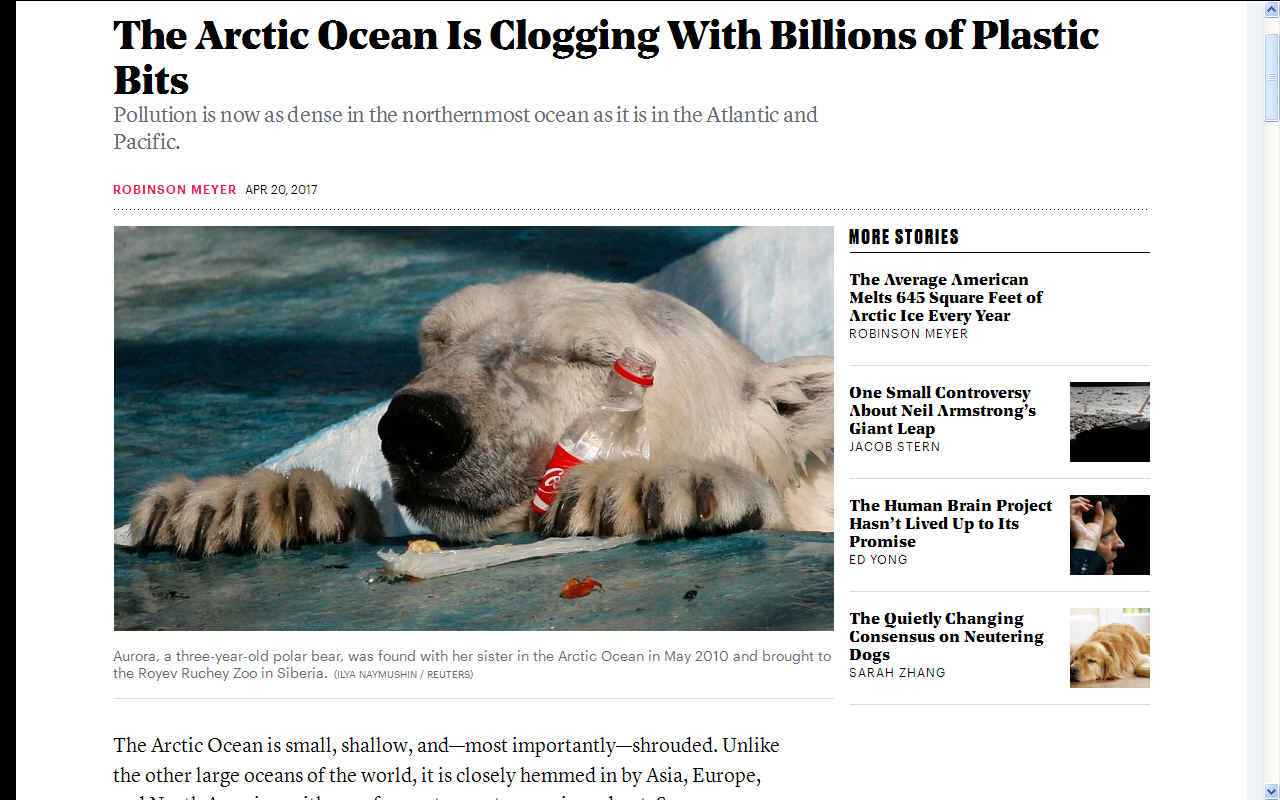
THE ATLANTIC 20 APRIL 2017 - ARCTIC CLOGGING WITH PLASTIC
Pollution is now as dense in the northernmost ocean as it is in the Atlantic and Pacific.
The Arctic Ocean is small, shallow, and—most importantly—shrouded. Unlike the other large oceans of the world, it is closely hemmed in by Asia, Europe, and North America, with very few watery entrances in and out. Some oceanographers call it the “Arctic Mediterranean Sea,” a nod both to its between-the-terra-ness and its similarity to that smaller ocean.
Often, that remoteness has played to its ecological advantage. Very few ships pass through the area (with all their attendant pollution and environmental disruption), at least compared to nearby waterways like the Bering Sea. It also helps that much of the Arctic freezes over every winter.
But a paper released this week in Science Advances argues that its location is now harming it. The first survey of the region has found that roughly 300 billion pieces of floating plastic, most of them tiny but visible to the unaided eye, have clogged the planet’s northernmost sea. The plastic, having been carried to the pole over decades, now has very few ways out.
In other words, the Arctic Ocean has become the Northern Hemisphere’s “dead end” for floating plastic.
“Our data demonstrate that the marine plastic pollution has reached a global scale after only a few decades using plastic materials,” said Andrés Cózar Cabañas, a biologist at the University of Cádiz. It is, he said, “a clear evidence of the human capacity to change our planet. This plastic accumulation is likely to grow further.”
The survey was carried out while the research vessel Tara circumnavigated the pole in late 2013. The same Tara cruise also surveilled local plankton populations and observed the aurora.
It found a couple key differences in how plastic pollution works in the Arctic. To the south, in the Atlantic and the Pacific Oceans, plastic tends to accumulate in enormous subtropical “trash patches.” While these are not the dense and churning gyres of garbage that many people imagine, they can be accurately described as parts of the ocean with a lot of garbage in them. In a way, they’re like the asteroid belt, an otherwise void place in the world-ocean where plastic is much more likely to accumulate.
The Arctic does not so much have trash patches inside it; it is giant trash patch. The Arctic Ocean has about the same median density of plastic as the Atlantic and Pacific do. But unlike in the southern oceans, where plastic has unevenly congregated in certain areas, it has spread itself throughout the entirety of the Arctic.
Sometimes, though, it is quite dense: In the seas north of Iceland and western Russia, there are hundreds of thousands of pieces of plastic per square kilometer.
Martha Buckley, an oceanographer at George Mason University, agrees with the authors that plastic is not coming from the Arctic itself. This is “intuitive,” she writes: Few people live around that ocean’s coast, there is little ship traffic there, and most of the plastic is tiny enough that it seems to have spent several years in the ocean. (The paper’s authors estimate that it takes one to three years for plastic from the North Atlantic to make it to the Arctic.)
“It is pretty clear that this plastic has been transported by ocean currents. How the plastics are entering the Arctic is not as clear,” she told me in an email. The paper, for instance, doesn’t discuss transport through the ocean’s vertical currents. Over the last few years, research has suggested that gyres in the subtropics and subpolar regions are linked by deeper currents.
Ocean currents matter because they’ll help researchers learn if the plastic is trapped in the Arctic permanently or whether it will eventually work its way out. Other scientists are still trying to come up with solutions to the world’s long-term plastic problem. In the meantime, says Cabañas, the only way to fix the problem is to mitigate its scale. Countries and coastal communities should work harder to keep plastic from winding up in the ocean.
“We should properly manage the plastic waste at its source,” he told me. “Once the plastic enters the ocean, its destination and impacts are uncontrollable.”
By Robonson Meyer
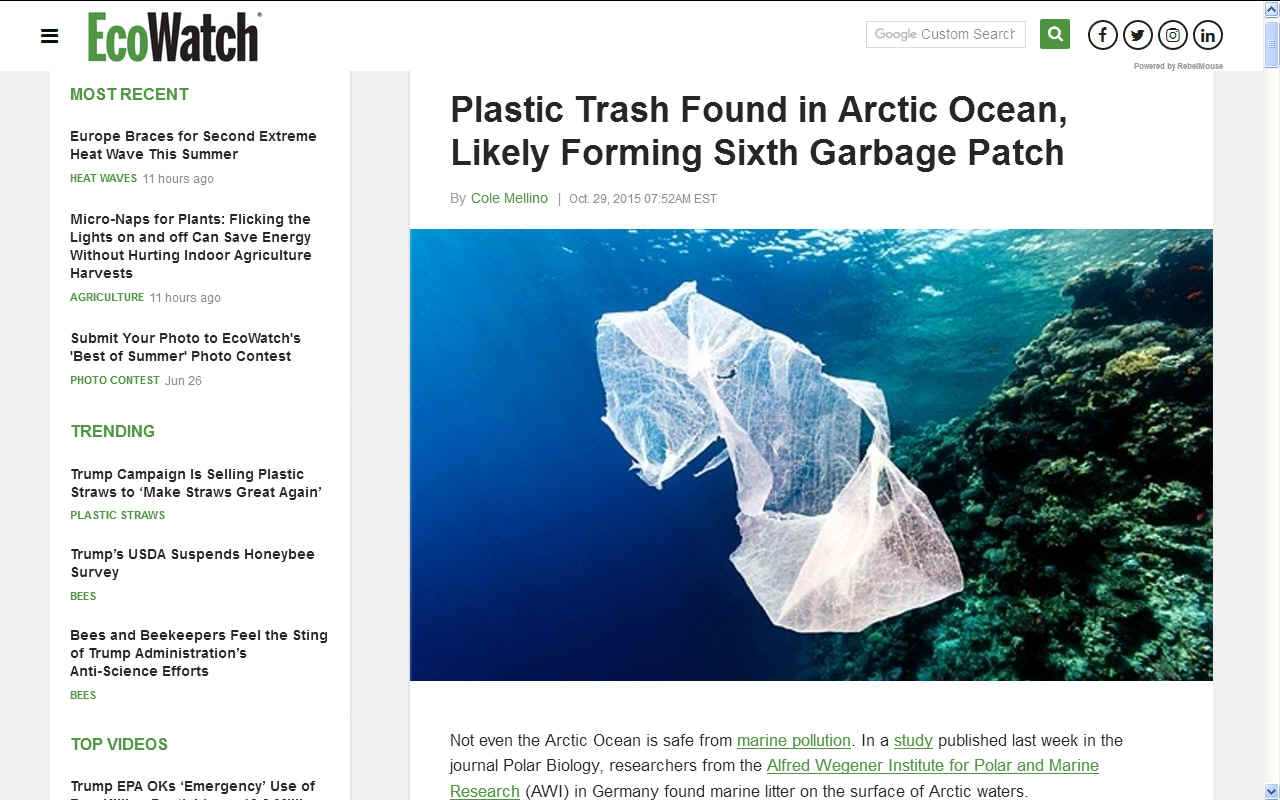
ECOWATCH
- In
2015 concerns as to the formation of another gyre were voiced all over the
internet.
IUCN 20 January 2016 - MICROPLASTICS IN THE ARCTIC OCEAN
Microplastics pollution in the Arctic and its effects on ecosystems, human health and ice formation and melting are the subject of a newly launched IUCN research project.
The pioneering project aims to assess the origins of microplastics and the effects of plastic ingestion on marine life as well as food safety consequences for humans. It will also analyse the physical and chemical impacts of microplastic presence in Arctic sea ice, including how it may affect formation and melting of ice.
With this information in hand, IUCN will provide recommendations to governments, industries, local communities and civil society to design mitigation solutions.
Korea Polar Research Institute (KOPRI) has offered to provide help from technical experts and access to their research vessel, Araon, the largest research icebreaker in the world. The project has also been endorsed by the GESAMP (UN Joint Group of Experts on the Scientific Aspects of Marine Environmental Protection).
There is an urgent need for research: specifically, the monitoring of types and quantity of marine plastics, as well as the development and implementation of a sustainable waste policy and legislation to mitigate the problem of microplastics.
Floating plastics have now become the most abundant type of marine litter. Slowly degrading large plastic items generate microplastic particles (qualified as such if between 1 and 5 mm in size), which can be transported over long distances by wind-driven ocean surface layer circulation.
Microplastics can also originate from personal care products (plastic beads used as abrasives less than 1 mm in size) which are washed down the drain and pass through treatment screens in wastewater plants.
Though many consider the Arctic as one of the last pristine environments on Earth, the Arctic Ocean is already affected by the trillions of pieces of plastic floating in our world’s oceans today. There is evidence suggesting that a sixth plastic gyre has formed within the area of the Barents Sea (Van Sebille et al 2012). If this is true, we could assume that microplastics accumulate in the region because of converging ocean currents, as is the case in the five other major ocean basin plastic gyres.
A recent study revealed that the Arctic is already a sink for microplastics transported from distant sources. Indeed, the Arctic Sea ice has been recently shown to contain a concentration of microplastics (mostly textile fibres) which far exceeds the ones previously reported in highly contaminated oceanic waters (plastic gyres) (Obbard et al. 2014). As the sea ice thaws, these particles are released into the water and might enter the food chain.
This discovery presents a serious human health concern, as approximately 40% of the United States’ commercial fisheries (by weight) come from the Bering Sea and about 50% of the fish consumed in the European Union comes from the European Arctic (Weildemann 2014). The problem is not limited to the Arctic: it affects us all.
IUCN has been working on microplastics since 2011, and is currently conducting expanded field research. The Union also established a stakeholder platform with a coalition of private sector, governments and NGOs to discuss and develop best practice solutions to address plastic and microplastics marine pollution.
The report Plastic debris in the ocean: The characterization of marine plastics and their environmental impacts; Situation analysis report by F. Thevenon, C. Caroll and J. Sousa, IUCN (2014) is the most recent scoping publication on the topic of plastics and microplastics.
IUCN invites all interested parties to participate in this ground-breaking project. The problem of microplastics pollution is vast and requires concerted effort from all parties concerned about the future of the Arctic.
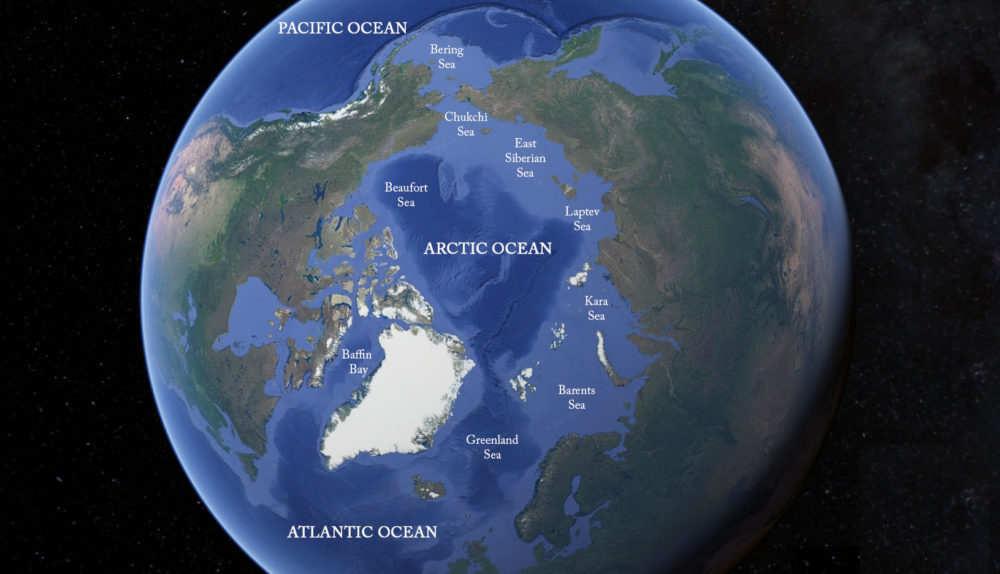
ABOUT THE IUCN
The International Union for Conservation of Nature (IUCN) is a membership Union uniquely composed of both government and civil society organisations. It provides public, private and non-governmental organisations with the knowledge and tools that enable human progress, economic development and nature conservation to take place together.
Created in 1948, IUCN has evolved into the world’s largest and most diverse environmental network. It harnesses the experience, resources and reach of its 1,300 Member organisations and the input of 14,500 experts. IUCN is the global authority on the status of the natural world and the measures needed to safeguard it. Our experts are organised into six commissions dedicated to species survival, environmental law, protected areas, social and economic policy, ecosystem management, and education and communication.
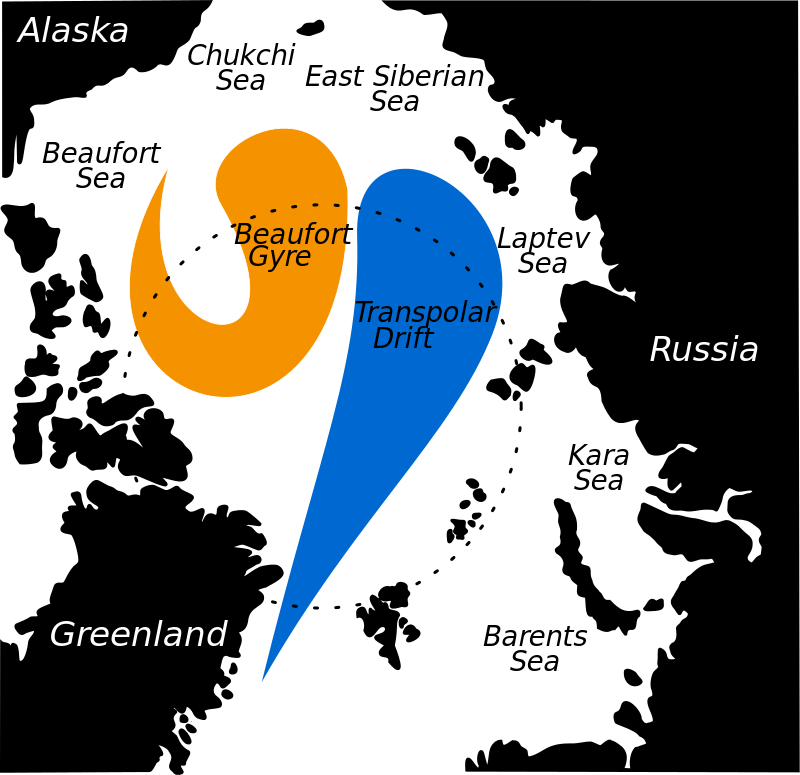
THE
BEAUFORT GYRE
The Beaufort Gyre has formed a dome of freshwater that has expanded vertically by about 15 centimetres (5.9 in) since 2002; by 2011 it had swelled to about 8,000 cubic kilometres (1,900 cu mi) in volume. The freshwater within this gyre represents about 10% of all the freshwater in the Arctic Ocean; the majority of the Arctic's freshwater supply originates from Russian rivers as runoff. The clockwise circulation of the Beaufort Gyre is induced by the wind patterns associated with the permanent anticyclonic high pressure system over the western part of the Arctic. In a clockwise-rotating gyre in the Northern Hemisphere, the Coriolis force causes the ocean water to flow inward toward the gyre's center where it accumulates, effectively forming a dome of water. If the wind patterns shift into a cyclonic circulation due to the residence of a low pressure system (rising air induced by warmer ocean temperatures a greater volume of open Arctic Ocean water), this will cause the circulation of the Beaufort Gyre to reverse and flow counter-clockwise. If this occurs, the Coriolis force would bend the flow out and away from the center of the gyre and, instead of the formation of a rising water dome, a depression would form and upwelling of the warmer water from the Atlantic ocean would occur.
Oceanographer Andrey Proshutinsky has theorized that if the winds and the gyre's circulation were to weaken, high volumes of freshwater could leak out of the eastern part of the Arctic Ocean into the Northern Atlantic Ocean, impacting the Thermohaline Circulation and thus climate.
Due to seasonal sea ice formation, the Beaufort Gyre is difficult to access and thus study in the Northern Hemisphere winter months; the lack of sunlight in these months forces the use of artificial light. Studies by Arthur S. Dyke and others show that if the volume of outflow of rivers into the Beaufort Gyre increase, the gyre itself might spatially shift toward the right. LINKS
& REFERENCE https://www.theatlantic.com/science/archive/2017/04/the-arctic-ocean-is-filling-with-billions-of-plastic-bits/523713/ https://www.ecowatch.com/plastic-trash-found-in-arctic-ocean-likely-forming-sixth-garbage-patch-1882115304.html https://www.iucn.org/content/microplastics-global-disaster-arctic-ocean
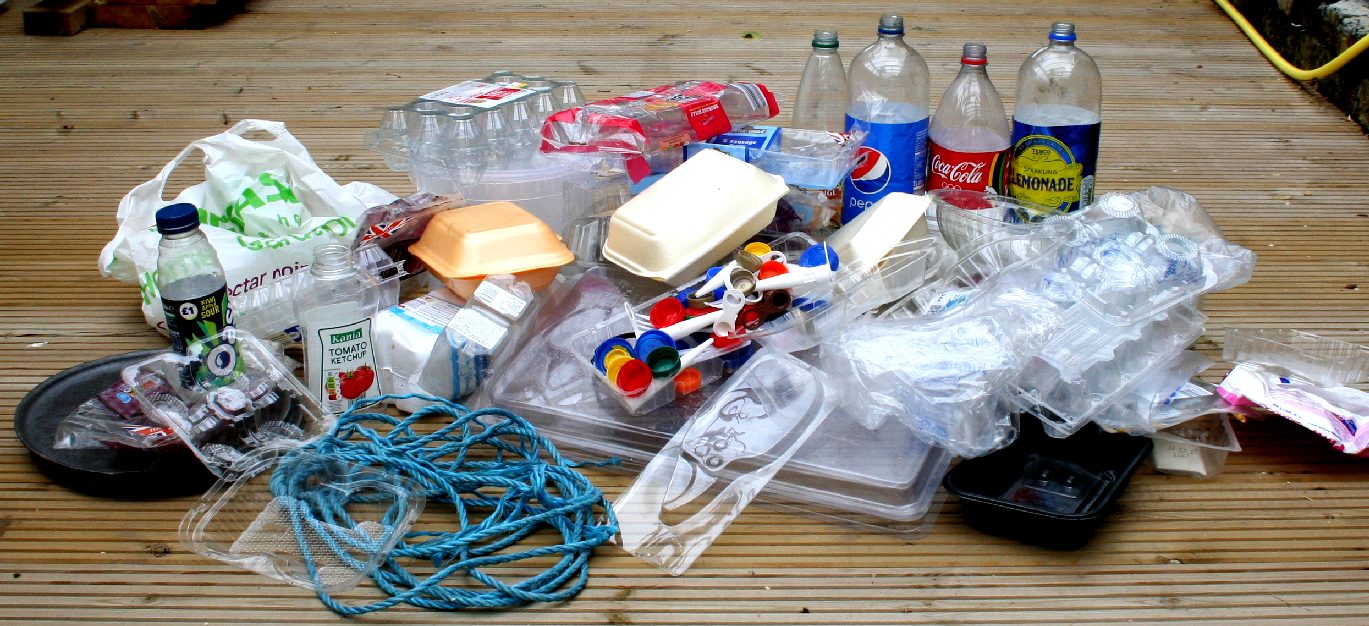
FAST
FOOD
- It's not just fast food, it
is our exploitative society that is poisoning the planet, without thought
for the consequences. We've been living at artificially low prices at the
expense of killing other life on earth.
|





